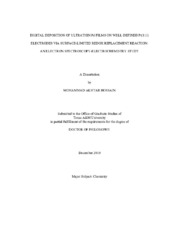| dc.contributor.advisor | Soriaga, Manuel P | |
| dc.creator | Hossain, Mohammad | |
| dc.date.accessioned | 2014-05-13T17:06:29Z | |
| dc.date.available | 2014-05-13T17:06:29Z | |
| dc.date.created | 2010-12 | |
| dc.date.issued | 2010-12-04 | |
| dc.date.submitted | December 2010 | |
| dc.identifier.uri | https://hdl.handle.net/1969.1/ETD-TAMU-2010-12-9027 | |
| dc.identifier.uri | https://hdl.handle.net/1969.1/151615 | |
| dc.description.abstract | In this study, ultrathin (submonolayer to eight-monolayer) Pd films were
deposited one layer at a time on well-defined Pt(111) surfaces via a process known as
surface-limited redox replacement reaction (SLR^3). In this digital-deposition method,
one monolayer of a nonnoble metal (Cu) is deposited on a noble metal (Pt) by
underpotential deposition (UPD). When the UPD adlayer is exposed to cations of less
reactive metals (Pd^2 ), it is oxidatively stripped and reductively displaced by the more
inert metal. The positive difference between the equilibrium potential of the noble metal
in contact with its solvated cations and the equilibrium potential of the UPD adlayer is
the driving force behind SLR^3. The Pd films were characterized by Auger electron
spectroscopy (AES), low-energy electron diffraction (LEED), and electrochemistry. The
LEED patterns indicated (1×1) surface structure of the deposited films. No residual Cu
was detected by AES in the Pd films. The Pd ultrathin films on Pt(111) showed HUPD
adsorption/desorption peaks which are not observed in bulk Pd. These peaks were observed even at 8 monolayer thick films. The interfacial structure and electrochemical
properties of SLR^3-prepared films were compared with those prepared by controlledpotential
deposition (CPD). There is a linear correlation between Cu deposition charge
(i.e., Pd deposition charge) and I-catalyzed Pd dissolution charge. Electrochemical and
LEED results suggest that SLR^3 prepared films are smooth (if not slightly smoother)
compared to those prepared by CPD. SLR^3 thus appears to be capable of preparing
atomically smooth ultrathin films on Pt(111) surfaces without any additional thermal or
electrochemical annealing. | en |
| dc.format.mimetype | application/pdf | |
| dc.subject | electrocatalyst | en |
| dc.subject | digital deposition | en |
| dc.subject | Under potential deposition | en |
| dc.subject | Pt(111) | en |
| dc.subject | Pd ultrathin films | en |
| dc.subject | galvanic displacement | en |
| dc.subject | Surface-limited redox replacement | en |
| dc.title | Digital Deposition of Ultrathin Pd Films on Well-Defined Pt(111) Electrodes via Surface-Limited Redox Replacement Reaction: An Electron Spectroscopy-Electrochemistry Study | en |
| dc.type | Thesis | en |
| thesis.degree.department | Chemistry | en |
| thesis.degree.discipline | Chemistry | en |
| thesis.degree.grantor | Texas A & M University | en |
| thesis.degree.name | Doctor of Philosophy | en |
| thesis.degree.level | Doctoral | en |
| dc.contributor.committeeMember | Vigh, Gyula | |
| dc.contributor.committeeMember | Brown, Lawrence S | |
| dc.contributor.committeeMember | Guo, Bing | |
| dc.type.material | text | en |
| dc.date.updated | 2014-05-13T17:06:30Z | |


